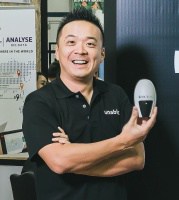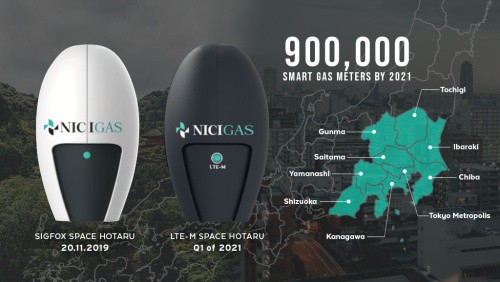Over the last 12 months, Nippon Gas Company (NICIGAS) has been upgrading its existing meters across Japan by attaching an IoT-based reader called Space Hotaru that would allow remote collection and transmission gas consumption data – in one of the largest smart utilities deployment to date.
In an exclusive interview, FutureIoT spoke with Philippe Chiu, co-founder and chief technology officer of UnaBiz, about the smart meter project in an in-depth interview that covers the impact of COVID-19, the importance of supply chain, challenges around customisation and integration and more.
Singapore-based UnaBiz is the product design and hardware device manufacturer, who together with SORACOM, developed the Space Hotaru from NICIGAS’ original concept.
(Second of three parts)
UnaBiz is nearly done with the phase 1 of the NICIGAS smart metre project, with the installation of 850,000 units of Space Hotaru in Japanese household within the month, overcoming the unavoidable delay caused the COVID-19 lockdowns.
Once a device is deployed, it goes live immediately and starts producing data that are fed into NICIGAS systems.

“The first layer is a hardware layer that is connected to the gas meter and enables access in and out, which means that you can read from the meter and you can send instructions to the meter, which means that it is a network access,” said Philippe Chiu, co-founder and chief technology officer of UnaBiz.
KDDI subsidiary SORACOM, a mobile operator that specialises in IoT, has been enlisted to deliver the software and the network connectivity between the devices and NICIGAS systems.
Integration is crucial to massive IoT projects
Chiu pointed out that the close-knit “triangle of collaboration and partnership” between NICIGAS, SORACOM and UnaBiz was the glue that has kept the smart metre project on a steady course, which was particularly crucial to manage the chaos that ensued with the supply chain disruptions caused by the COVID-19 pandemic.
“To pipe to proper data onto the traditional systems, it's not a complete new solution. It's integrating with what the existing platforms. And this is done commonly between UnaBiz and SORACOM, which has the field knowledge and proper communication to facilitate efficiency between the teams,” said Chiu.
Initially, there were 700,000 units that have to be deployed, and that would mean a very large number per day of installed meters of Space Hotaru. To do that, Chiu emphasised the need for constant synchronisation of and management of operations.
“It is often a point that people fail to consider. We are talking about an actual device being deployed all across hundreds or even thousands of square kilometres, and you need actual people, and not robots to do this,” he said.
Chiu added that Integration is not just about software side of things – to which people are very used which involves data and others.
“It starts with real life, pure hardware and the actual field integration of that. This has been the heavy work. And it is not just the physical installation, there is a lot of testing tools on the field. Not every field installator has a PhD. So, you have to have extremely optimised, simplified field application and deployment,” he said, adding that a deployment mobile application has been created that is very specialised and dedicated to roll out.
This mobile deployment application is enabling the project team to move fast with installation and to sustain the speed of implementation.
“If we take the pace at which this project has been rolled out and how efficient it was, it would not be fair, not to mention the integration at the hardware layer. Data will come back, but it would probably be the second or third layer after that. But we need to first have the connection. The integration work starts at this point, the whole logistic, operation, synchronisation and management with the field teams of NICIGAS and even their contractors,” Chiu said.
“Deployment operations, which involves hardware, mobile apps, cloud services and others, are extremely important. I believe that in the post-COVID era, the whole logistic industry will have a whole new set of ecosystem and partners managing that chaos,” he added.
Furthermore, Chiu said the integration involves a lot of supply chain work, having all of these devices, reaching the right locations, direct check points, having them connected to the right meters.
“This is a tremendous work, and we can never do that by ourselves, and that is where local presence is absolutely necessary. That is why UnaBiz is very close to SORACOM, and NICIGAS is extremely happy about that,” he said.
No wasted network signal
According to Chiu, the project team deploys a mixed technology solution network-wise, citing that Space Hotaru is actually a family of products – the initial device supports Sigfox 0G low-power network and a new version that supports 4G.
“It is a solution with different types of hardware for different radio protocols. In remote area, we use the LTE-M version which is a lighter version of 4G, or we have Sigfox and 4G combined, depending on the situation,” he said. “We have to optimise how the device communicates, and in simpler words, it means we are not wasting any single bit of the signal.”
Indeed, UnaBiz has completely design from ground up the network protocols, the way the device dialogues with Sigfox or the 4G. “This know-how is our competitive edge,” Chiu said.
Almost 100% device customisation
UnaBiz designed and developed the Space Hotaru specifically to work and integrate with NICIGAS gas meters.
“ We have customised 98% of the smart reader – the remaining 2%t is the standardisation of the gas metre as established by the Japanese authorities,” Chiu said. “Luckily, the Space Hotaru is not by itself supporting 80 different meters, that has 80 different standards as that would have taken a lot more time. Space Hotaru is matching the gas meter standard, established in Japan.”
Furthermore, UnaBiz optimised the casing and firmware inside Space Hotaru.
“The initial version NICIGAS had had three times more battery capacity compared to the final version. We had to optimise the whole behaviour of the device such that you do not having to purchase such huge batteries to be placed in the device, which is saving cost,” Chiu said.
Also, the company designed the Space Hotaru in a way that would enable NICIGAS to take the data from the device the way it does from any other IT systems.
“If we go deeper and it ends up in the JSON format. In this way, it is easier for them to ingest the data to integrate with the existing system. It would have been a very big difficulty if they had to customise something specific to accept Space Hotaru,” Chiu explained.
He added: “The customisation happens between as close to the meter, all the way to the middleware and then it's standardised and sent properly to NICIGAS. It is similar to the petroleum industry. When you get the crude oil, you can't just put that in your car. You have to transform that oil, optimise it and make it arrive at the right gas station and then it's edible by the cars. That’s why it's customised because all that route did not exist before. The different layers of the hardware, networking and application are completely customised and designed for that.”
Unabiz believes massive IoT projects work best when the IoT hardware is purpose-built.
“Most of the time, the behaviour of the device, the way it's attached, etc. is almost always customised 100%. It is very different from the vision of IoT, where I buy a device, put it on my set, and I can do it by myself.
“We don't believe that massive IoT can happen by off-the-shelf solutions. This might sound cheap and low-cost to do but it is not sustainable. Most of the time, it will face multiple issues and it’s not helping, because – in the end - the top management would see IoT as a failure rather than an opportunity.”
Next: All about data and the future of IoT projects
Related story: Under the hood: Supply chain essential to massive IoT projects



